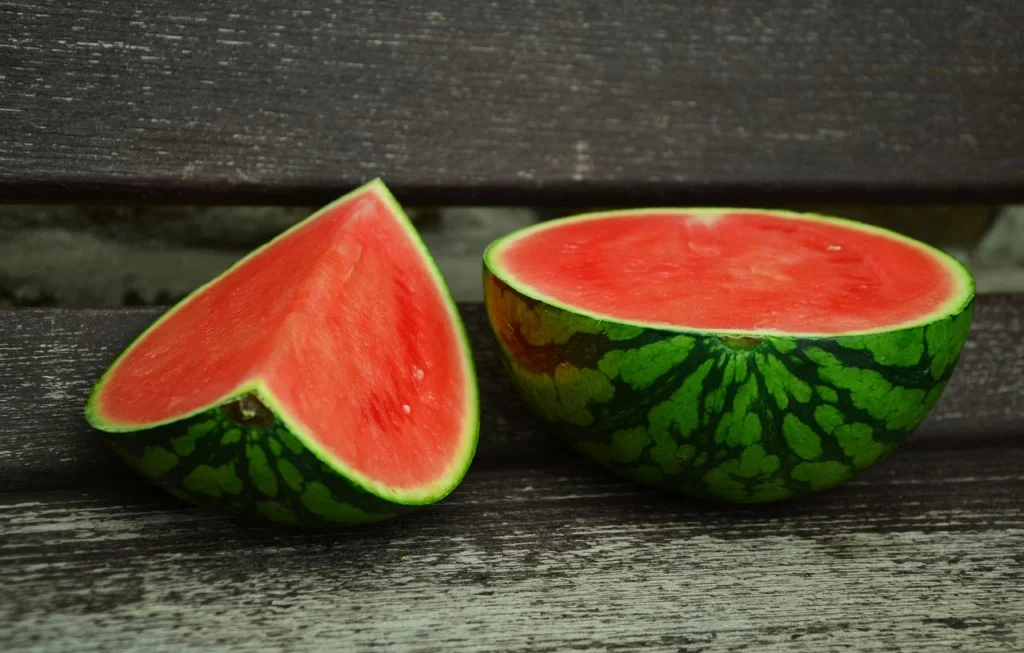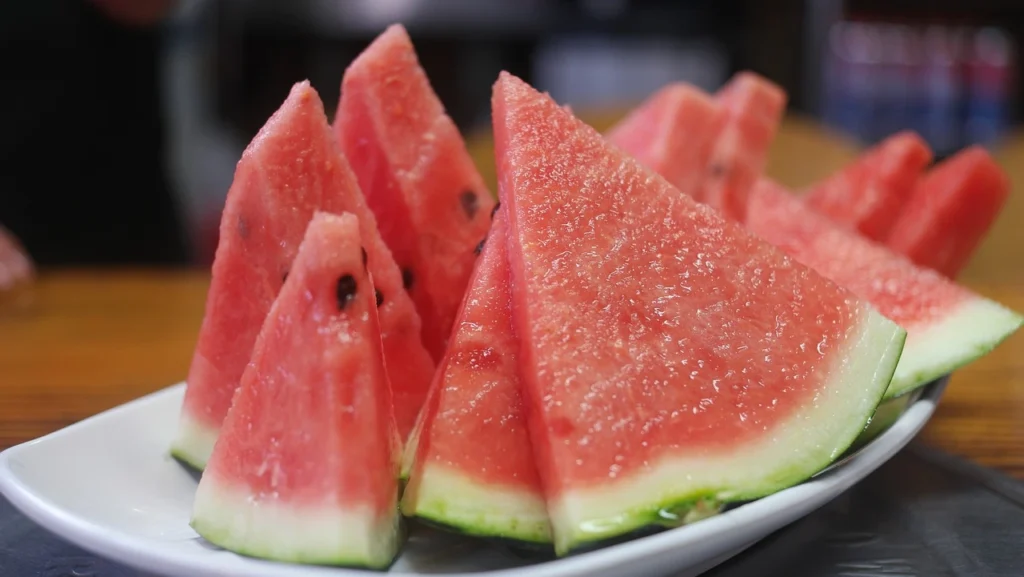Can Dogs Eat Watermelon?

Picture this: you’re slicing into a juicy watermelon on a hot afternoon, and those puppy-dog eyes lock onto your treat. Before sharing, let’s explore how this refreshing fruit fits into your pet’s diet.
Watermelon offers hydration and essential nutrients, making it a popular warm-weather snack. The flesh contains vitamins A and C, while being 92% water – perfect for keeping pets cool. But those black seeds and tough rind? They’re not part of the deal.
Preparation matters more than you might think. Always remove seeds to prevent digestive issues, and skip the rind entirely. When served properly, this sweet treat can be both safe and enjoyable for your four-legged companion.
This guide combines veterinary insights with practical tips to help you make informed decisions. We’ll break down portion sizes, creative serving ideas, and red flags to watch for – because your pet’s safety always comes first.
Understanding Watermelon as a Healthy Treat for Your Dog

On sweltering summer days, sharing a slice of nature’s candy with your furry friend might seem tempting. This vibrant fruit offers more than just a sweet flavor—it’s packed with elements that support your pet’s well-being when prepared correctly.
Nutritional Benefits and Hydration
With over 90% water content, this juicy snack acts like a portable hydration station for active pets. Its natural moisture helps regulate body temperature during outdoor adventures while providing essential electrolytes. Unlike processed treats, it delivers nutrients without artificial additives.
Key Vitamins, Minerals, and Low-Calorie Content
Every bite contains:
- Vitamin A for healthy skin and vision
- Vitamin C to boost immune function
- Potassium for proper muscle and nerve activity
At just 30 calories per cup, it’s ideal for maintaining a healthy weight. The fiber content supports digestion, while natural sugars provide quick energy bursts. Remember: these benefits only shine when the fruit complements a balanced diet rather than replacing meals.
Always consult your vet before introducing new foods, especially for pets with health conditions. Start with small portions to gauge tolerance, and never substitute water with fruit-based hydration.
Dogs Eat Watermelon: Safety Tips & Preparation Guidelines
Before offering a juicy treat, knowing how to prepare it safely is crucial. Follow these steps to transform this summer favorite into a risk-free snack your companion will love.
Removing Seeds and Rind to Prevent Blockage
Start by scrubbing the fruit’s exterior under running water to remove dirt or pesticides. Slice it into manageable pieces, then use a spoon to scoop out seeds. Even a few leftover seeds could lead to intestinal blockage in sensitive pets.
The tough green skin and white inner rind pose serious risks. These parts are difficult to digest and may cause gastrointestinal distress. Always serve only the soft red flesh to avoid emergency vet visits.
Appropriate Portion Sizes and Feeding Frequency
Treats should never exceed 10% of your pet’s daily calories. For smaller breeds, start with a teaspoon-sized portion. Larger animals can handle up to half a cup of cubed fruit twice weekly.
Introduce new fruits slowly over three days to monitor for loose stools or vomiting. Adjust quantities based on your companion’s reaction, and always pair snacks with fresh water to balance natural sugar content.
Creative Ways to Serve Watermelon to Your Dog

Transform summer snacking into an exciting experience with these vet-approved serving methods. The key lies in balancing creativity with safety while keeping portions controlled.
Fresh Chunks and Frozen Treats
Cut seedless flesh into thumb-sized chunks for easy chewing. Smaller breeds do best with pea-sized pieces to prevent choking. For a frosty surprise, freeze these portions on a baking sheet overnight.
Frozen cubes become natural chew toys that cool paws during walks. Always supervise your pet to ensure they don’t bite off more than they can handle. Pair with fresh water to maximize hydration benefits.
DIY Recipes Like Watermelon “Ice Cream”
Blend 1 cup of seedless fruit with ½ cup plain yogurt (xylitol-free) until smooth. Pour into silicone molds and freeze for 4 hours. This vitamin-packed dessert offers probiotics for gut health.
“The cold texture soothes teething puppies while providing essential nutrients,” notes a canine nutritionist. Stick to small servings—about a tablespoon per 10 pounds of body weight—to avoid stomach upset.
Rotate between fresh and frozen foods to keep treats interesting. Always remove the rind and double-check for stray seeds before serving. Remember: even good dogs need moderation to maintain balanced diets.
Monitoring Your Dog’s Reaction to Watermelon
After introducing a new snack, vigilance becomes your best tool. Watch your companion closely during the first 24 hours to spot unusual behaviors or physical changes.
Spotting Digestive Red Flags
Common signs of intestinal upset include vomiting within 2-6 hours or loose stools. Bloating and excessive gas may indicate difficulty processing fiber. If symptoms persist beyond 12 hours, contact your vet immediately.
| Symptom | Possible Cause | Action Required |
|---|---|---|
| Repeated vomiting | Seed/rind ingestion | Emergency vet visit |
| Skin hives | Allergic reaction | Antihistamines (vet-prescribed) |
| Lethargy | Dehydration or blockage | Hydration check + exam |
Allergy Awareness and Response
Though rare, allergies can develop. Watch for facial swelling, excessive scratching, or sudden diarrhea. “Any new food carries allergy risks,” warns Dr. Ellen Torres, DVM. Keep a symptom journal noting timing and severity for vet consultations.
Start with thumbnail-sized portions during initial feedings. Gradually increase amounts over three days if no issues arise. Always balance summer treats with regular meals to maintain nutritional harmony.
Additional Precautions When Introducing New Fruits
Expanding your pet’s menu requires thoughtful planning beyond basic preparation. While fruits like seedless melon offer benefits, every animal’s digestive system responds differently to dietary changes.
Professional Guidance Matters
Always schedule a vet consultation before adding new items to meals. Special dietary needs or existing health conditions might require adjustments you wouldn’t anticipate. A recent study found 38% of digestive issues in pets stem from abrupt food changes without medical input.
The Gradual Integration Method
Start with thumbnail-sized portions mixed into regular meals. This slow approach helps identify tolerance levels while minimizing risks of upset stomach. If no adverse reactions occur over 72 hours, gradually increase quantities under veterinary supervision.
Balance is crucial—even healthy snacks should never replace more than 10% of daily calories. Watch for subtle signs like changes in energy levels or stool consistency. Pair new treats with familiar foods to ease transitions and maintain nutritional harmony.
“Sudden dietary shifts can disrupt gut bacteria,” explains Dr. Sarah Lin, a board-certified veterinary nutritionist. Her team recommends tracking reactions in a journal to share during checkups. This proactive approach helps tailor diets to your companion’s unique needs while preventing blockage risks from improper portions.
Related post: Are Milk Bones Bad For Dogs?
Conclusion
When sharing snacks with your furry companion, thoughtful preparation ensures enjoyment without risks. This summer fruit delivers hydration and essential vitamins when served properly—always remove seeds and avoid the tough outer layer to prevent digestive issues.
Creative serving methods like frozen cubes or blended treats add variety while keeping portions controlled. Remember: treats shouldn’t exceed 10% of daily calories, and gradual introduction helps spot upset stomach signs early.
Watch for unusual behavior after feeding, especially diarrhea or lethargy. Consult your vet if symptoms persist—they’ll help tailor snack plans to your pet’s needs while maintaining nutritional balance.
By following these guidelines, you transform a simple fruit into a safe, refreshing reward. Keep safety first, moderation central, and those tails wagging all season long.
FAQ
Can pets have watermelon as a snack?
Yes, in moderation. The flesh is safe and hydrating. Avoid seeds and rind to prevent intestinal issues.
What health benefits does this fruit offer?
It’s rich in vitamins A and C, potassium, and lycopene. Low in calories, it supports hydration and immune health.
How do I prepare it safely?
Remove seeds to avoid blockage, and cut off the rind. Serve bite-sized chunks to prevent choking.
Are there creative serving methods?
Try freezing cubes or blending with plain yogurt for a cool treat. Avoid added sugars or artificial ingredients.
How often can I feed it to my pet?
Offer small portions once or twice weekly. Overfeeding may lead to stomach upset due to natural sugars.
What reactions should I monitor?
Watch for diarrhea, vomiting, or lethargy. These may indicate digestive sensitivity or allergies. Discontinue use if symptoms arise.
Should I consult a vet before adding it to their diet?
Yes, especially if your pet has health conditions like diabetes. A vet can advise on portion control and frequency.




